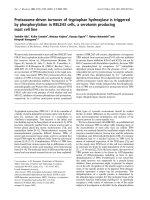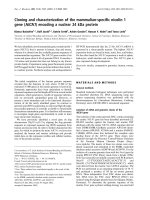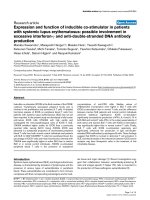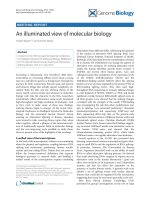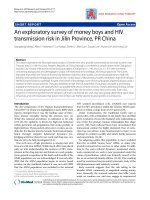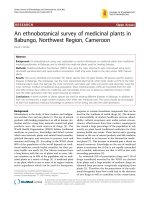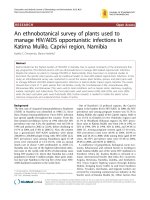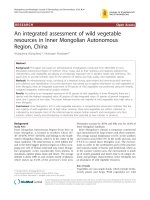Báo cáo y học: "An unusual presentation of brucellosis, involving multiple organ systems, with low agglutinating titers: a case repor" ppsx
Bạn đang xem bản rút gọn của tài liệu. Xem và tải ngay bản đầy đủ của tài liệu tại đây (236.13 KB, 3 trang )
BioMed Central
Page 1 of 3
(page number not for citation purposes)
Journal of Medical Case Reports
Open Access
Case report
An unusual presentation of brucellosis, involving multiple organ
systems, with low agglutinating titers: a case report
Farzin Khorvash*, Ammar H Keshteli, Mohaddeseh Behjati, Mansoor Salehi
and Alireza Emami Naeini
Address: Department of Infectious and Tropical Diseases, Alzahra University Hospital, School of Medicine, Isfahan University of Medical Sciences,
Isfahan, Iran
Email: Farzin Khorvash* - ; Ammar Hassanzadeh Keshteli - ;
Mohaddeseh Behjati - ; Mansoor Salehi - ; Alireza Emami Naeini -
* Corresponding author
Abstract
Background: Brucellosis is a multi-system disease that may present with a broad spectrum of
clinical manifestations. While hepatic involvement in brucellosis is not rare, it may rarely involve
the kidney or display with cardiac manifestations. Central nervous system involvement in
brucellosis sometimes can cause demyelinating syndromes. Here we present a case of brucella
hepatitis, myocarditis, acute disseminated encephalomyelitis, and renal failure.
Case presentation: A 26-year-old man presented with fever, ataxia, and dysarthria. He was a
shepherd and gave a history of low grade fever, chilly sensation, cold sweating, loss of appetite,
arthralgia and 10 Kg weight loss during the previous 3 months. He had a body temperature of 39°C
at the time of admission. On laboratory tests he had elevated level of liver enzymes, blood urea
nitrogen, Creatinine, Creatine phosphokinase (MB), and moderate proteinuria. He also had
abnormal echocardiography and brain MRI. Enzyme-linked immunosorbent assay for IgG and IgM
was negative. Standard tube agglutination test (STAT) and 2-mercaptoethanol (2-ME) titers were
1:80 and 1:40 respectively. Finally he was diagnosed with brucellosis by positive blood culture and
the polymerase chain reaction for Brucella mellitensis.
Conclusion: In endemic areas clinicians should consider brucellosis in any unusual presentation
involving multiple organ systems, even if serology is inconclusive. In endemic areas low STAT and
2-ME titers should be considered as an indication of brucellosis and in these cases additional testing
is recommended to rule out brucellosis.
Background
Brucellosis is still an important public health problem
and endemic in many countries, especially in Mediterra-
nean areas, parts of south and Central America, and east
and western Africa [1]. It is the most common zoonosis in
the world; accounting for the annual occurrence of more
than 500,000 cases [2]. Brucellosis is a systemic disease
and may involve any organ system.
Here, we present a patient with brucella hepatitis, myocar-
ditis, acute disseminated encephalomyelitis, and renal
failure with low agglutinating titers.
Published: 21 July 2007
Journal of Medical Case Reports 2007, 1:53 doi:10.1186/1752-1947-1-53
Received: 5 February 2007
Accepted: 21 July 2007
This article is available from: />© 2007 Khorvash et al; licensee BioMed Central Ltd.
This is an Open Access article distributed under the terms of the Creative Commons Attribution License ( />),
which permits unrestricted use, distribution, and reproduction in any medium, provided the original work is properly cited.
Journal of Medical Case Reports 2007, 1:53 />Page 2 of 3
(page number not for citation purposes)
Case presentation
A 26-year-old man referred to our center (Alzahra Univer-
sity Hospital, Isfahan, Iran) with complaints of fever,
ataxia and dysarthria. His problem began 3 months prior
to the recent hospitalization with low grade fever, chilly
sensation, cold sweating, loss of appetite and 10 Kg
weight loss. He was also complaining from arthralgia in
different joints and could not walk without help. His dys-
arthria and vomiting started 10 and 2 days before the
admission, respectively. He had undergone left nephrec-
tomy for congenital urethropelvic junction obstruction
and severe hydronephrosis 2 years ago. He was symptom
free up to the recent referral.
Physical examination revealed an ill looking young man
with body temperature of 39°C, pulse rate 45/Min, and
blood pressure of 110/60 mm Hg. He was dysarthteric
and truncal ataxia was also observed. On auscultation he
had muffled heart sounds without any murmur. The
abdomen was soft with tender hepatomegaly 3 cm below
the costal margin.
Results of laboratory tests made on admission were as fol-
low: White blood cell count: 17300/mm
-3
with 91%Neu-
trophils, Patelet count: 89000/mm
-3
, Hemoglobin: 14.1
g/dl, C-reactive protein: 15 mg/dl, Erythrocyte sedimenta-
tion rate: 41 mm/h, Blood urea nitrogen(BUN): 40 mg/
dL, Creatine(Cr): 3.9 mg/dL, SGOT: 338 mg/dL, SGPT:
151 mg/dL, Alkaline phosphatase: 593 mg/dL, Creatine
phosphokinase(CPK): 468 mg/dL, CPK(MB): 38 mg/dL,.
Urinalysis revealed moderate hematuria and 24-hour uri-
nalysis (U.A) revealed proteinuria (1143 mg/dL). ANA,
ANCA, anti-dsDNA, RF, Anti Cardiolopin Ab, Lupus Anti-
coagulant were all negative. A PPD skin test was negative.
Chest X ray was normal. Electrocardiogram showed sinus
bradycardia and high T waves in the precordial leads.
Echocardiographic examination revealed septal hypoki-
nesia and ejection fraction of 30%. No vegetation was
reported. Brain MRI showed white matter changes in cor-
pus callosum, periventricular area and centrum semiova-
lis (Fig. 1). Liver and kidney biopsies as well as lumbar
puncture were not performed due to our patient's refusal.
Since he was a shepherd from an endemic area for brucel-
losis and gave a history about the consumption of non-
pasteurized dairy products, standard tube agglutination
test (STAT), 2-mercaptoethanol (2-ME), and Coombs test
were performed (Antigen from the Pasteur Institute of
Iran, Tehran). STAT and 2-ME titers were 1:80 and 1:40
respectively. Titer of Coombs test was 1:80. Enzyme-
linked immunosorbent assay (IBL, Germany) for IgG and
IgM was negative. Blood culture was performed once and
it was positive for brucellosis. The Brucella omp2a gene was
used as target DNA for PCR amplification. Polymerase
chain reaction-restriction fragment length polymorphism
(PCR-RFLP) [5] demonstrated the presence of Brucella
mellitensis bv 1. Doxycycline (2 × 100 mg/day p.o.) and
Rifampicin (1 × 600 mg/day p.o.) were started. The
patient received this treatment for six weeks. One week
after the initiation of the treatment our patient's symp-
toms subsided and he became afebrile. After 2 weeks he
had normal liver function tests, BUN, and Cr levels and
transthoracic echocardiography was normal too. The
patient was followed-up for 10 months. In 6
th
months he
experienced a relapse of brucellosis with signs and symp-
toms similar to the previous episode of the infection. The
standard treatment regimen was started again. He is now
receiving this treatment and is asymptomatic but still dys-
arthric. Our plan is to continue the medication for at least
6 months.
Discussion
Hepatic involvement in brucellosis is not rare and
hepatomegaly may be documented in 15–20% of cases
[3]. However, liver function tests are usually mildly ele-
vated [1,3]. The spectrum of pathological findings in bru-
cella hepatitis is varied. Granulomatous hepatitis, diffuse
hepatitis without granuloma and focal necrosis have been
reported [4]. Our patient was diagnosed as having bru-
cella hepatitis because of extreme elevation of the hepatic
enzymes that subsequently returned to the normal value
with treatment.
Brain MRI showing white matter changes (hyperintensities) in different parts such as periventricular area, thalamus, and centrum semiovalisFigure 1
Brain MRI showing white matter changes (hyperintensities) in
different parts such as periventricular area, thalamus, and
centrum semiovalis.
Journal of Medical Case Reports 2007, 1:53 />Page 3 of 3
(page number not for citation purposes)
The central nervous system is involved in 5–7% of cases
and such complications often have an ominous progno-
sis. Meningitis, encephalitis, meningoencephalitis,
meningovascular disease, brain abscesses, and demyeli-
nating syndromes have all been reported [5]. We suggest
our patient may be a case of neurobrucellosis too. Unfor-
tunately lumbar puncture was not performed because he
did not give permission for that. Brain MRI findings were
consistent with acute disseminated encephalomyelitis
(ADEM), and his truncal ataxia resolved after the treat-
ment. The resolution for dysarthria was partial. The dura-
tion of therapy for neurobrucellosis is generally
prolonged, varying from 1 to 19 months. Thus we believe
our patient has been mismanaged at first and this may be
the reason for the relapse of the infection.
Brucellosis may, however, rarely involve the kidney caus-
ing acute interstitial nephritis, pyelonephritis, and IgA
nephropathy which may cause proteinuria, hematuria,
and pyuria. It may also cause caseating granulomas and
calcifications [6]. Patients with brucella glomerulonephri-
tis almost always have urinary sediment abnormalities,
proteinuria, and/or azotemia, but exact diagnosis is gener-
ally established with resolution of the clinical findings
after antibiotic treatment for brucellosis [7]. In this case,
microscopic hematuria, proteinuria, and increased BUN
and Cr levels were detected during the initial laboratory
analysis. Renal biopsy was not performed which might
have helped in diagnosing the type of renal involvement.
In our patient, renal function tests reached base line and
U.A abnormalities resolved after the treatment.
Our patient is a case of brucella myocarditis too. Cardiac
complications from brucellosis are unusual, occurring in
0–2% of patients and usually manifest as endocarditis [8].
Myocarditis is a rare complication of adult brucellosis and
in most instances it is in electrocardiographic and/or
echocardiographic diagnosis [9]. Our patient had abnor-
mal echocardiographic findings and elevated levels of
CPK (MB), which is due to myocyte necrosis in myocardi-
tis.
Our patient reported a disease history of about 3 months.
Whilst it has been shown that patients with subacute bru-
cellosis usually present with relatively high agglutinating
antibody titers [10], the agglutinating antibody titers in
our patient were low.
The diagnostic criteria for brucellosis in endemic regions
are a titer ≥ 1:320 in STAT and/or a titer ≥ 1:160 in 2-ME
[11]. The absolute diagnosis of brucellosis requires isola-
tion of the bacterium from blood or tissue samples [5].
While our patient is a definite case of brucellosis by blood
culture and PCR, according to the above criteria he doesn't
have brucellosis for low titers of serologic tests.
Conclusion
In endemic areas clinicians should consider brucellosis in
any unusual presentation involving multiple organ sys-
tems, even if serology is inconclusive. In endemic areas
low STAT and 2-ME titers should be considered as an indi-
cation of brucellosis and in these cases additional testing
is recommended to rule out brucellosis.
Authors' contributions
FK wrote the manuscript and was involved with the
patient's management. AHK participated in the clinical
care of the patient and the writing of the case report. MB
wrote the manuscript and was involved with the patient's
management. MS performed blood culture and PCR of
the patient. AEN wrote the manuscript and was involved
with the patient’s management. All authors read and
approved the final manuscript.
Competing interests' declaration
The author(s) declare that they have no competing inter-
ests.
Acknowledgements
Written consent was obtained from the patient for publication of the arti-
cle. We also wish to thank Mohammad Hassanzadeh and Michael Misamore
at University of Western Ontario (London, Canada) and Dr. Samar
Sayedyahossein at Isfahan University of Medical Sciences (Isfahan, Iran) for
their excellent comments to prepare the final manuscript.
References
1. Young EJ: Brucella species. In Principles and Practice of Infectious Dis-
eases 5th edition. Edited by: Mandell GL, Bennett JE, Dolin R. New
York: Churchill Livingstone; 2000:2386-93.
2. Pappas G, Papadimitriou P, Akritidis N: The new global map of
human brucellosis. Lancet Infect Dis 2006, 6(2):91-9.
3. Sunmez S, Cagatay A, Karadeniz A, Ozsut H, Eraksoy H, Calangu S: A
case of acute hepatitis due to brucellosis. South Med J 2006,
99:632-3.
4. Aygen B, Sumerkan B, Doganay M, Sehmen E: Prostatitis and hep-
atitis due to Brucella melitensis: a case report. J Infect 1998,
36:111-2.
5. Pappas G, Akritidis N, Bosilkovski M, Tsianos E: Brucellosis. N Engl
J Med 2005, 352:2325-36.
6. Odeh M, Oliven A: Acute brucellosis associated with massive
proteinuria. Nephron 1996, 72:688-9.
7. Ustun I, Ozcakar L, Arda N, Duranay M, Bayrak E, Duman K, Atabay
M, Cakal BE, Altundag K, Guler S: Brucella glomerulonephritis:
case report and review of the literature. South Med J 2005,
98:1216-7.
8. Garcia de Lucas MD, Castillo Dominguez JC, Martinez Gonzalez MS:
Brucella myopericarditis. Rev Esp Cardiol 2004, 57:709.
9. Jubber AS, Gunawardana DR, Lulu AR: Acute pulmonary edema
in Brucella myocarditis and interstitial pneumonitis. Chest
1990, 97:1008-9.
10. Irmak H, Buzgan T, Evirgen O, Akdeniz H, Demiroz AP, Abdoel TH,
Smits HL: Use of the Brucella IgM and IgG flow assays in the
serodiagnosis of human brucellosis in an area endemic for
brucellosis. Am J Trop Med Hyg 2004, 70(6):688-94.
11. Roushan MR, Amin MJ, Abdoel TH, Smits HL: Application of a
user-friendly Brucella-specific IgM and IgG antibody assay
for the rapid confirmation of Rose Bengal-positive patients
in a hospital in Iran. Trans R Soc Trop Med Hyg 2005, 99:744-50.

